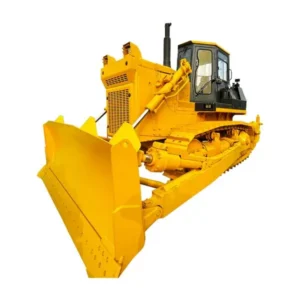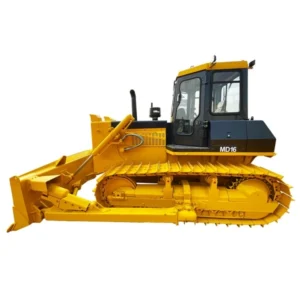معرفی
Bulldozers are powerful machines essential for various construction, mining, and land-clearing projects. One of the most critical components of a bulldozer is its tracks. Choosing the best bulldozer tracks for your specific needs can significantly impact the machine’s performance, efficiency, and lifespan. This comprehensive guide will help you understand the factors to consider when selecting bulldozer tracks, ensuring you make an informed decision that meets your operational requirements.
Understanding Bulldozer Tracks

What Are Bulldozer Tracks?
Bulldozer tracks, also known as track chains or undercarriage tracks, are the continuous tracks or tread systems that enable bulldozers to traverse rough terrain, providing stability and traction. These tracks are crucial for distributing the machine’s weight, minimizing ground pressure, and enhancing maneuverability on various surfaces.
Types of Bulldozer Tracks
There are several types of bulldozer tracks, each designed for specific applications and conditions. The main types include:
- Standard Tracks: Ideal for general-purpose use on various terrains.
- Heavy-Duty Tracks: Built for demanding tasks and harsh environments.
- Low-Ground-Pressure (LGP) Tracks: Designed for soft, muddy, or sensitive surfaces to reduce ground pressure.
- Abrasion-Resistant Tracks: Enhanced with materials to withstand abrasive conditions such as rocky or sandy terrain.
Factors to Consider When Choosing Bulldozer Tracks
Terrain and Operating Conditions
The type of terrain and operating conditions significantly influence the choice of bulldozer tracks. For example, LGP tracks are suitable for soft and muddy surfaces, while abrasion-resistant tracks are better for rocky or abrasive environments. Understanding your working conditions will help you select tracks that provide optimal performance and durability.
Load and Application
Consider the typical load and application of your bulldozer. Heavy-duty tracks are designed for high-load applications and demanding tasks such as mining or large-scale construction. For lighter tasks or general-purpose use, standard tracks may suffice. Matching the track type to the application ensures efficient and safe operation.
Track Material and Design
The material and design of the tracks affect their durability and performance. Tracks made from high-quality steel or other robust materials are ideal for heavy-duty applications. Additionally, the design features, such as track width and grouser height, influence traction and ground pressure. Select tracks with the appropriate material and design features for your specific needs.
تعمیر و نگهداری و تعویض
Consider the ease of maintenance and availability of replacement parts when choosing bulldozer tracks. Tracks that are easy to inspect, maintain, and replace reduce downtime and operational costs. Opt for tracks from reputable manufacturers that offer comprehensive support and readily available spare parts.
Budget and Cost-Effectiveness
While high-quality tracks may have a higher upfront cost, they often provide better performance and longevity, leading to cost savings in the long run. Evaluate your budget and consider the total cost of ownership, including maintenance and replacement costs, when selecting bulldozer tracks.
Table: Comparison of Different Types of Bulldozer Tracks
| Track Type | Ideal Terrain/Conditions | Key Features | Typical Applications | Cost Range |
|---|---|---|---|---|
| Standard Tracks | Various terrains | Versatile, general-purpose | General construction | Moderate |
| Heavy-Duty Tracks | Harsh environments | High durability, load capacity | Mining, heavy construction | High |
| Low-Ground-Pressure (LGP) | Soft, muddy, sensitive surfaces | Wide tracks, reduced ground pressure | Wetlands, forestry | Moderate to High |
| Abrasion-Resistant Tracks | Rocky, abrasive conditions | Enhanced material for abrasion resistance | Quarrying, demolition | High |
Benefits of Choosing the Right Bulldozer Tracks
عملکرد پیشرفته
Selecting the right bulldozer tracks enhances the machine’s performance by providing optimal traction, stability, and maneuverability. This ensures efficient operation and reduces the risk of slippage or bogging down, especially in challenging conditions.
Increased Durability
High-quality tracks designed for specific applications last longer and withstand harsh conditions better. This reduces the frequency of replacements and minimizes downtime, leading to higher productivity and cost savings.
Improved Safety
Properly selected tracks improve the safety of the bulldozer operation by ensuring better stability and control. This is particularly important when working on uneven or challenging terrains, where the risk of accidents is higher.
مقرون به صرفه بودن
Investing in the right tracks can be cost-effective in the long run. Durable tracks reduce maintenance and replacement costs, while enhanced performance leads to faster project completion and lower operational expenses.
Versatility and Flexibility
Choosing the appropriate tracks for your bulldozer allows for greater versatility and flexibility in different applications. Whether you’re working in construction, mining, forestry, or demolition, the right tracks enable your bulldozer to perform optimally across various tasks.
How to Maintain Bulldozer Tracks

Regular Inspection
Regularly inspect your bulldozer tracks for signs of wear, damage, and misalignment. Look for cracks, loose bolts, and excessive wear on the track links and rollers. Early detection of issues can prevent more significant problems and extend the lifespan of the tracks.
Proper Cleaning
Keep the tracks clean from dirt, mud, and debris that can accelerate wear and cause damage. Use high-pressure water or air to clean the tracks after each use, especially if operating in muddy or abrasive conditions.
Lubrication
Proper lubrication of the track components, such as rollers, pins, and bushings, is essential for reducing friction and wear. Follow the manufacturer’s recommendations for lubrication intervals and use the appropriate lubricants.
Tension Adjustment
Ensure the tracks are correctly tensioned to prevent excessive wear and improve performance. Overly tight tracks can cause premature wear, while loose tracks can lead to slippage and damage. Regularly check and adjust the tension as needed.
Timely Replacement
Replace worn or damaged tracks promptly to avoid further damage to the bulldozer and ensure safe operation. Keep spare parts readily available and follow the manufacturer’s guidelines for replacement intervals.
نتیجه
Choosing the best بولدوزر tracks for your needs involves understanding your operating conditions, application requirements, and budget constraints. By considering factors such as terrain, load, track material, and maintenance, you can select tracks that enhance your bulldozer’s performance, durability, and safety. Regular maintenance and timely replacement further ensure that your tracks remain in optimal condition, contributing to the overall efficiency and cost-effectiveness of your operations.
سوالات متداول
What are the main types of bulldozer tracks?
The main types of bulldozer tracks include standard tracks, heavy-duty tracks, low-ground-pressure (LGP) tracks, and abrasion-resistant tracks. Each type is designed for specific terrains and applications.
How do I choose the right bulldozer tracks for my needs?
To choose the right bulldozer tracks, consider the terrain and operating conditions, load and application, track material and design, maintenance requirements, and budget. Understanding these factors will help you select tracks that provide optimal performance and durability.
Why are low-ground-pressure (LGP) tracks used for soft and muddy terrains?
LGP tracks are designed with wider track shoes to distribute the bulldozer’s weight over a larger surface area, reducing ground pressure. This makes them ideal for soft and muddy terrains, preventing the machine from sinking or getting stuck.
How often should I inspect and maintain my bulldozer tracks?
Regular inspection and maintenance are crucial for extending the lifespan of your bulldozer tracks. Inspect the tracks daily or before each use, clean them regularly, lubricate moving parts as recommended by the manufacturer, and check the tension periodically.
What are the benefits of using abrasion-resistant tracks?
Abrasion-resistant tracks are enhanced with materials that withstand abrasive conditions, such as rocky or sandy terrains. They offer increased durability, reducing the frequency of replacements and maintenance, and providing cost savings in the long run.








-150x150.webp)
